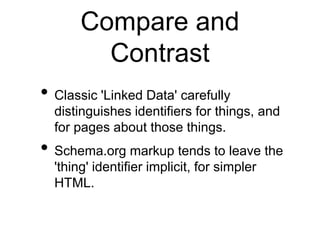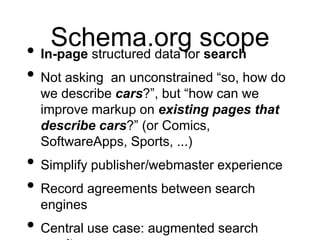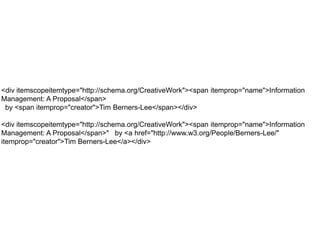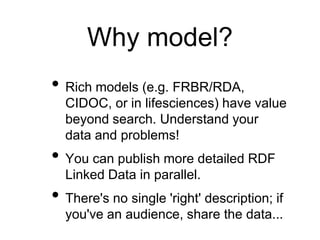NISO/DCMI Webinar: Schema.org and Linked Data: Complementary Approaches to Publishing Data
- 1. niso.org dublincore.org NISO/DCMI Webinar Schema.org and Linked Data: Complementary Approaches to Publishing Data http://www.niso.org/news/events/2012/dcmi/linked_data NISO/DCMI Webinar: April 25, 2012
- 2. "Schema.org and Linked Data: Complementary Approaches to Publishing Data" NISO/DCMI Joint Webinar 2012-04-25 Dan Brickley<[email protected]> http://www.niso.org/news/events/2012/dcmi/linked_data/
- 3. Webinar Overview • Intro: Schema.org, Linked Data & RDF • A quick look at schema.org • A longer look at Linked Data and RDF • Advantages and Challenges of RDF / Linked Data • Schema.org in detail • Combining Linked Data and schema.org • The Future, and what it may hold
- 4. Goals • Show common origins of schema.org and Linked Data • Illustrate the different design choices available • for identifying real-world entities • syntaxes for describing things in structured data • for integrating multiple vocabularies • for incentives to publish (accurate, detailed) data • usability, expressivity and pluralism • ...helping guide adoption of schema.org + Linked Data
- 5. Schema.org A quick look.
- 9. For example?
- 11. <div itemscopeitemtype="http://schema.org/VideoObject"> <h2>Video: <span itemprop="name">My Title</span></h2> <meta itemprop="duration" content="T1M33S" /> <meta itemprop="thumbnailUrl" content="thumbnail.jpg" /> <meta itemprop="embedUrl" content="http://example.com/videoplayer.swf?video=123" /> <object ...> <embed type="application/x-shockwave-flash" ...> </object> <span itemprop="description">Video description</span> </div> Type: http://schema.org/VideoObject name = My Title duration = T1M33S thumbnailurl = thumbnail.jpg embedurl = http://www.example.com/videoplayer.swf?video=123 description = Video description
- 12. (this is almost all you need to know about RDF, incidentally)
- 13. How does it work? • Normal HTML page content, with additional markup. • Extra attributes are from W3C HTML5 Microdata: itemscope, itemtype, itemprop, content. • The HTML5 Microdata syntax was based originally on W3C RDFa, a similar design. • Both address the principle known on microformats.org as "Don't Repeat Yourself" (DRY), http://microformats.org/wiki/dry . • Re-use of page markup to also serve as structured data.
- 14. Linked Data Where did it come from... ...and where is it going?
- 15. Linked Data: Prehistory • Before going deeper, let's go back to the origins of Linked Data publication strategies. • 'Linked Data' as a slogan and community began with a Tim Berners-Lee note (July 2006) which inspired a Linking Open Data community group and who in turn inspired many others to publish linked, structured data. • What was new about the 'Linked Data' recipe? How did it improve upon previous RDF practice 1997- 2005? How does it compare to the structured data style of schema.org? How did we move from having only a handful of linked RDF files in 2002, through millions to today's talk of billions?
- 16. Linked Data 1.Use URIs as names for things. 2.Use HTTPURIs so that people can look up those names. 3.When someone looks up a URI, provide useful information, using the standards (RDF, SPARQL, ...). 4.Include links to other URIs so they can discover more things. Tim Berners-Lee (2006) http://www.w3.org/DesignIssues/LinkedData
- 17. From FOAF to Linked Data • TimBL's 'Linked Data' note critiqued FOAF's style of linking, since FOAF 2000-2005 did not encourage use of 'http:' identifiers for people and real-world things. • Instead, FOAF files used a "reference by description" style, describing people in terms of their properties, with "seeAlso" links into a Web of linked RDF documents. • "This [Friend of a Friend] linking system was very successful, forming a growing social network, and dominating, in 2006, the linked data available on the web. " (TimBL 2006) • "However, the system has the snag that it does not give URIs to people, and so basic links to them cannot be made." • Post-2007 (with supporting changes in the standards)
- 18. Linked RDF: Growth • In 2002, an early FOAF crawl found RDF about 24 people. • By 2006 (see Jennifer Golbeck 'Web-based Social Networks A Survey and Future Directions') we saw: • LiveJournal.com: 7,500,000 FOAF profiles • Ecademy.com: 72,000 FOAF profiles • Trust project: 1,700 FOAF profiles • ...others, totalling 6 million+ site-based profiles • plus smaller number of "in the wild" FOAF files
- 19. 2002: all the Linked RDF we crawled could fit on a t-shirt: RDFWeb: a network of linked FOAF files (there was also RSS, DC, Mozilla ... but not very linked) ...by 2006 finding millions of files. soon after, 'billion triples challenge'.
- 20. Linked Data • The Linking Open Data community took this further, and quickly: publishing structured data from database-backed sites allows very rapid growth. • LOD data was primarily in RDF/XML (rather than RDFa) • The big shift: publishing structured data from databases • LOD data typically assigned http: URIs to real-world things • LOD structured data was rarely constrained by need to fit human-facing HTML • LOD structure typically authored by RDF experts using a diverse mix of several RDF vocabularies
- 21. 2007-05 (each blob here is a dataset, not an entity described!)
- 22. 2009-03
- 23. 2011-09
- 24. The Big Shift • LOD's explicit focus on publishing entire datasets boosted adoption massively. • Assigning Web identifiers to real-world things made data merging and linking much easier than in earlier work. • The cloud diagram inspired other outside the core RDF community; proof-of-concept conversions evolved into 'officially hosted' participation (e.g. LCSH.info&id.loc.gov) • Technical publication details remained 'fiddly' (HTTP redirects, debates about URI structure) but an energetic community helped early adopters find their way. • Buzz around "Web 2.0", APIs and open data fed this
- 26. The Basic Idea: Links and claims • In Linked RDF (both FOAF and Linked Data): • Pages (documents) express claims about the world. • Linked documents describe Linked entities. • This idea dates from the earlier days of the Web. • Understanding this gives an understanding of the entire design space we are exploring with Linked Data, schema.org and RDF-based languages. • Many technical issues are clearer when you realise there are two kinds of links involved...
- 27. June 2000: The basic idea behind FOAF is simple: the Web is all about making connections between things. FOAF provides some basic machinery to help us tell the Web RDFWeb intro about the connections between the things that matter to us. Thousands of people already do this on the Web by describing themselves and their lives on their home page. Using FOAF, you can help machines understand your home page, and through doing so, learn about the relationships that connect FOAF is best explained with an people, places and things described on the Web. FOAF uses W3C's RDF example. Consider a Web of inter- technology to integrate information from your home page with that of your friends, related home pages, each describing and the friends of your friends, and their friends.. things of interest to a group of friends. Each new home page that appears on the Web tells the world something new, providing factoids and gossip that make the Web a mine of disconnected Dan lives in Zetland road, Bristol, UK with Libby and Craig. Dan's email snippets of information. FOAF provides address is [email protected]. Libby's email address is a way to make sense of all this. Here's [email protected]. Craig's is [email protected]. Dan and Libby an example, a fragment from the work for an organisation called "ILRT" whose website is at http://ilrt.org/. mostly-fictional FOAF database. First Craig works for "Netgates", an organisation whose website is at we list some facts, then describe how http://www.netgates.co.uk/. Craig's wife Liz lives in Bristol with Kathleen. the FOAF system makes it possible to Kathleen and Liz also work at "Netgates". Damian lives in London. Martin explore the Web learning such things. knows Craig, Damian, Dan and Libby quite well. Martin lives in Bristol and has an email address of [email protected]. (etc...) This kind of information is the sort of thing typically found on Web home pages. The extract shown here indicates how short, stylised factual sentences can be used to characterise a Web of relationships between people, places, organisations and documents. In real life, this information would be most likely be distributed across various Web pages created by the individuals listed. Very likely, their pages will link directly or indirectly to the home pages of countless other friends-of-friends-of-friends.
- 28. Claims • Many pages are about some particular thing, e.g. a person or a movie or book. • They describe various properties of that thing, often in terms of links to other things; these are claims that can be treated as structured data. • RDFa, Microdata and Microformats explore this in HTML, Linked Data mostly in other formats.
- 32. Image credits: Tim Berners-Lee, Ian Davis
- 40. Two kinds of link
- 42. Links • Links between documents, links between things. • As we compare Linked Data and schema.org, we'll see different tradeoffs being made. • Linked Data: an emphasis on richness of description and linkage, over human-readability and webmaster usability. • Schema.org: simplifies expressivity and weaker linkage, as a tradeoff for greater webmaster/publisher usability. • These are practical differences of emphasis and focus, rather than conflicts or different architectures. • Both styles share the RDF data model, and can be blended together in several ways.
- 44. But why? • Let's now take a few minutes to talk and think about incentives for publishing structured data. • The incentives for publishing Linked RDF have matured over the years, and this has some effect on our technical choices... • Who will be publishing, with what tooling, and for what reason?
- 45. INCENTIVES
- 48. FOAFCorp
- 50. Google Social Graph API
- 55. Incentives • FOAF developer appeal 2000-7: fun demos; networks are intrinsically inspirational; general love of open data, APIs. Publisher appeal: it was easy and futuristic. • Linked Data dev/publisher appeal 2007-2012: inspirational sense of an [open|linked] data 'movement' captured by the evocative and ever-growing cloud diagram. • The data itself became a major asset; supporting technology was a means to
- 56. Incentives: schema.org • Schema.org: More (and better) Web traffic. • A very mainstream message relevant to maintainers of millions of Web sites • To sustain massive non-expert influx, some dramatic simplifications
- 57. ETERNAL SEPTEMBER? "Eternal September (also September that never ended)[1] is a Usenet slang expression, coined by Dave Fischer, for the period beginning September 1993. It's moot now. September 1993 will go down in net.history as the September that never ended. "The expression encapsulates the belief that an endless influx of new users (newbies) since that date has continuously degraded standards of discourse and behavior on Usenet and the wider Internet." Is schema.org the Eternal September of the Semantic Web?
- 58. Compare and Contrast • Classic 'Linked Data' carefully distinguishes identifiers for things, and for pages about those things. • Schema.org markup tends to leave the 'thing' identifier implicit, for simpler HTML.
- 59. Comparison (2.) • Classic Linked Data: values rich, highly interlinked descriptions that use different independently created vocabularies. • Schema.org: 300+ classes, 300+ properties in a single schema, addressing many more use cases without mixing vocabularies.
- 61. Schema.org • Search engine collaboration: • Google, Bing, Yahoo! &Yandex • Simple factual data for better search • Launched June 2011, schema.org schema • 300 classes, 261 properties & growing • discussions: W3C WebSchemas group
- 62. Example: Google Rich Snippets From: http://www.google.com/webmasters/tools/richsnippets See also Yandex's http://webmaster.yandex.ru/microtest.x
- 63. On IMDB: <div id="content-2-wide" itemscopeitemtype="http://schema.org/CreativeWork"> <div class="txt-block"> <h4 class="inline">Stars:</h4> <a onclick="(new Image()).src='/rg/title-overview/star- 1/images/b.gif?link=%2Fname%2Fnm0010930%2F';" href="/name/nm0010930/" itemprop="actors">Douglas Adams</a>, <a onclick="(new Image()).src='/rg/title- overview/star-2/images/b.gif?link=%2Fname%2Fnm0048982%2F';" href="/name/nm0048982/" itemprop="actors">Tom Baker</a> and <a onclick="(new Image()).src='/rg/title-overview/star- 3/images/b.gif?link=%2Fname%2Fnm3035100%2F';" href="/name/nm3035100/" itemprop="actors">Hans Peter Brondmo</a> </div> <div class="star-box" itemprop="aggregateRating" itemscopeitemtype="http://schema.org/AggregateRating"> Linked Data: see http://www.imdb.com/name/nm0010930/ for schema.org markup describing Douglas Adams as a http://schema.org/Person (jobTitle, birthDate, description, performerIn, ...).
- 64. What’s in the schema? • Classes (types) e.g. LocalBusiness, Person, Organization, VideoObject, TVSeries... • Properties (attributes) e.g. openingHours, transcript, productionCompany, streetAddress • That’s all - a dictionary of terms, used for annotating data within normal Web pages
- 65. CreativeWork event UserInteraction LocalBusiness intangible place Organization CivicStructure Landform
- 66. Another example:
- 67. <div itemscopeitemtype="http://schema.org/Restaurant"> <span itemprop="name">GreatFood</span> <div itemprop="address" itemscopeitemtype="http://schema.org/PostalAddress"><span itemprop="streetAddress">1901 Lemur Ave</span> <span itemprop="addressLocality">Sunnyvale</span>, <span itemprop="addressRegion">CA</span> <span itemprop="postalCode">94086</span></div> <span itemprop="telephone">(408) 714-1489</span> <a itemprop="url" href="http://www.dishdash.com">www.greatfood.com</a> Hours: <meta itemprop="openingHours" content="Mo-Sa 11:00-14:30">Mon-Sat 11am- 2:30pm <meta itemprop="openingHours" content="Mo-Th 17:00-21:30">Mon-Thu 5pm- 9:30pm <meta itemprop="openingHours" content="Fr-Sa 17:00-22:00">Fri-Sat 5pm- 10:00pm Categories: <span itemprop="servesCuisine">Middle Eastern</span>, <span itemprop="servesCuisine">Mediterranean</span> </div>
- 68. Schema.org scope • In-page structured data for search • Not asking an unconstrained “so, how do we describe cars?”, but “how can we improve markup on existing pages that describe cars?” (or Comics, SoftwareApps, Sports, ...) • Simplify publisher/webmaster experience • Record agreements between search engines • Central use case: augmented search
- 69. Lots missing! e.g. sports • Current vocabulary emphasizes 'points of interest' on a map and sporting activities rather than sports content 'as entertainment' • We also have terms to describe videos, TV shows etc., ...but no sports-specifics yet • How deep to go? How to integrate with existing vocabulary? How to identify players, teams, kinds of 'football'? Video
- 70. http://www.w3.org/wiki/WebSchemas/SchemaDotOrgProposals Job postings (done), rNews(done), Comics, Learning, ScholaryArticle, Software, Events, Genealogy, Real Estate, eCommerce, Health, Sports, Transport, Vehicles, Comments, Datasets, Bio, ... (+bugfixes, integration, ...)
- 71. Everything overlaps * • We added JobPosting; what if the job was sports-related? • We're adding educational markup; does it help describe sports education, training? • Is there a sports perspective on the health/medical vocabulary we're working on? • Can't coordinate everything! Pragmatism... * 'intertwingularity'
- 72. Practicalities • Delegation to external sources for enumerations and detail • e.g. country codes from UN FAO or Wikipedia/DBpedia/Wikidata • We don’t want to create big enumerations • all the countries? sports? things that go on maps? • Decentralisedsubclassing& property values
- 73. Process • Search partners retain ultimate oversight • W3C hosts community group, discussion, wiki and proposal tracking • Web Schemas group - planning monthly telecons at W3C, based around proposals • Evolving, pragmatic, collaborative
- 74. Schema.org • Shares roots with decentralized Linked Data, including RDF graph data model • Can be seen as a form of Linked Data • Page-based markup and mainstream adoption require emphasis on simplicity • Pragmatic, evolving and co-operative approach
- 76. (this is almost all you need to know about RDF, incidentally)
- 79. <div itemscopeitemtype="http://schema.org/CreativeWork"><span itemprop="name">Information Management: A Proposal</span> by <span itemprop="creator">Tim Berners-Lee</span></div> <div itemscopeitemtype="http://schema.org/CreativeWork"><span itemprop="name">Information Management: A Proposal</span>" by <a href="http://www.w3.org/People/Berners-Lee/" itemprop="creator">Tim Berners-Lee</a></div>
- 81. Historically... • the Linked Data community improved on the early FOAF/RDFWeb linking model by adding explicit URI identifiers for entities. • Schema.org's need for publisher simplicity softens this guideline, making more work for consumers but more data for everyone.
- 82. Practical Convergence • Using "External enumerations" to add detail to schema.org descriptions - subtypes and property values. • Using separate Linked Data files to publish rich detail. • Using Linked Data tooling to consume schema.org data and mix with other RDF.
- 83. Common Questions • Q: Should we stop all our modeling work and just use schema.org since it is understood by the search engines? • A: No! But consider using schema.org too...
- 84. Why model? • Rich models (e.g. FRBR/RDA, CIDOC, or in lifesciences) have value beyond search. Understand your data and problems! • You can publish more detailed RDF Linked Data in parallel. • There's no single 'right' description; if you've an audience, share the data...

















![From FOAF to Linked
Data
• TimBL's 'Linked Data' note critiqued FOAF's style of
linking, since FOAF 2000-2005 did not encourage use
of 'http:' identifiers for people and real-world things.
• Instead, FOAF files used a "reference by description"
style, describing people in terms of their properties,
with "seeAlso" links into a Web of linked RDF
documents.
• "This [Friend of a Friend] linking system was very
successful, forming a growing social network, and
dominating, in 2006, the linked data available on the
web. " (TimBL 2006)
• "However, the system has the snag that it does not
give URIs to people, and so basic links to them
cannot be made."
• Post-2007 (with supporting changes in the standards)](https://image.slidesharecdn.com/nisodcmiwebinar25april2012print-120426140920-phpapp02/85/NISO-DCMI-Webinar-Schema-org-and-Linked-Data-Complementary-Approaches-to-Publishing-Data-17-320.jpg)











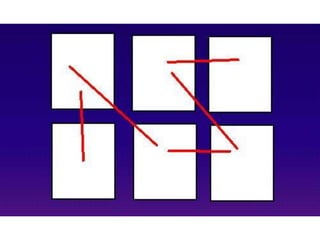







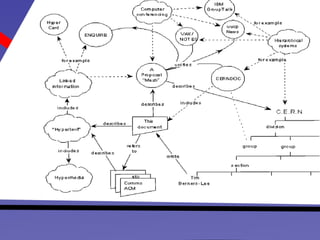

















![Incentives
• FOAF developer appeal 2000-7: fun
demos; networks are intrinsically
inspirational; general love of open data,
APIs. Publisher appeal: it was easy
and futuristic.
• Linked Data dev/publisher appeal
2007-2012: inspirational sense of an
[open|linked] data 'movement' captured
by the evocative and ever-growing
cloud diagram.
• The data itself became a major asset;
supporting technology was a means to](https://image.slidesharecdn.com/nisodcmiwebinar25april2012print-120426140920-phpapp02/85/NISO-DCMI-Webinar-Schema-org-and-Linked-Data-Complementary-Approaches-to-Publishing-Data-55-320.jpg)

![ETERNAL
SEPTEMBER?
"Eternal September (also September that never ended)[1] is a Usenet slang
expression, coined by Dave Fischer, for the period beginning September 1993.
It's moot now. September 1993 will go down in net.history as the September that never ended.
"The expression encapsulates the belief that an endless influx of new users (newbies)
since that date has continuously degraded standards of discourse and behavior on
Usenet and the wider Internet."
Is schema.org the Eternal September of the Semantic Web?](https://image.slidesharecdn.com/nisodcmiwebinar25april2012print-120426140920-phpapp02/85/NISO-DCMI-Webinar-Schema-org-and-Linked-Data-Complementary-Approaches-to-Publishing-Data-57-320.jpg)
